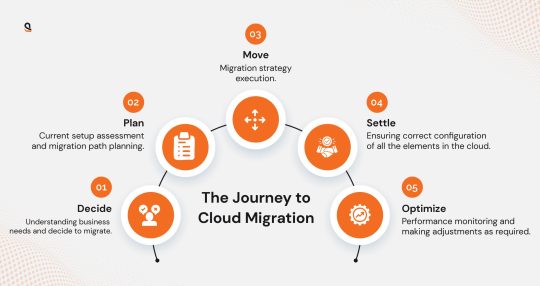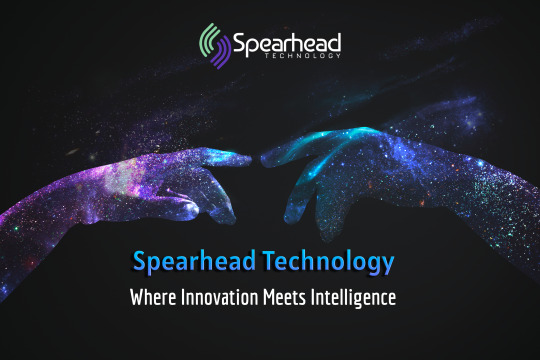#itmodernization
Explore tagged Tumblr posts
Text

Unlock Cloud Success: Master the 6 R’s of Cloud Migration with AQe Digital
At AQe Digital, we don’t just migrate your business to the cloud — we help you choose the right path for long-term success. Whether you're just starting out or ready for full-scale digital transformation, our cloud experts guide you through the 6 R’s of Cloud Migration: Rehost, Replatform, Repurchase, Retain, Retire, and Refactor.
🔍 Each strategy is tailored to your unique goals, challenges, and existing IT setup — because we believe there's no one-size-fits-all in transformation.
🚀 From simple "lift and shift" methods to complex re-architecting, AQe Digital empowers businesses to:
Streamline operations
Boost scalability & security
Reduce IT costs
Embrace innovation faster
Let us help you transform your infrastructure while keeping your business running smoothly.
#CloudMigration#6RsOfCloudMigration#DigitalTransformation#CloudStrategy#RehostToRefactor#ITModernization#CloudSolutions#ScalableIT#InnovationDriven
1 note
·
View note
Text
Making hybrid cloud work for midmarket organizations involves balancing on-premises infrastructure with cloud flexibility to optimize cost, performance, and scalability. With the right strategy, midmarket companies can enhance agility, data control, and business continuity.
0 notes
Text

#SAPManagedServices#SAPOptimization#EnterpriseITSupport#BusinessAgility#DigitalTransformation#ProphecyTech#SAPSolutions#SystemPerformance#SeamlessOperations#ManagedITServices#ITEfficiency#SAPSupport#TechForBusiness#SmartEnterprise#ITModernization
0 notes
Link

Explore the global ERP software market forecast through 2030, featuring key trends like AI integration, composable ERP, and cloud adoption. Includes regional and segmental insights, with CAGR projections and vendor analysis.
#ERPMarket#CloudERP#AIinERP#ComposableERP#DigitalTransformation#EnterpriseSoftware#ERP2030#SaaSERP#SMEs#ITModernization
0 notes
Text
As organizations look to modernize infrastructure and migrate legacy virtual machines (VMs) to container-native environments, Red Hat OpenShift Virtualization emerges as a powerful solution. A crucial step in this migration journey is configuring and managing storage for virtual machines effectively — especially when orchestrated through Ansible Automation Platform.
Why Storage Configuration Matters in VM Migration
Virtual machines, unlike containers, are tightly coupled with persistent storage:
VM disks can be large, stateful, and performance-sensitive.
Improper storage configuration can result in data loss, slow I/O, or failed migrations.
OpenShift Virtualization relies on Persistent Volume Claims (PVCs) and StorageClasses to attach virtual disks to VMs.
🎯 Key Objectives of Storage Configuration
Ensure Data Integrity – Retain disk states and OS configurations during migration.
Optimize Performance – Choose appropriate backends (e.g., block storage for performance).
Enable Automation – Use Ansible playbooks to consistently define and apply storage configurations.
Support Scalability – Configure dynamic provisioning to meet demand elastically.
🔑 Types of Storage in OpenShift Virtualization
Persistent Volumes (PVs) and Claims (PVCs):
Each VM disk maps to a PVC.
StorageClass defines how and where the volume is provisioned.
DataVolumes (via Containerized Data Importer - CDI):
Automates disk image import (e.g., from an HTTP server or PVC).
Enables VM creation from existing disk snapshots.
StorageClasses:
Abstracts the underlying storage provider (e.g., ODF, Ceph, NFS, iSCSI).
Allows admins to define performance and replication policies.
How Ansible Automates Storage Setup
The Ansible Automation Platform integrates with OpenShift Virtualization to:
Define VM templates with storage requirements.
Automate DataVolume creation.
Configure PVCs and attach to virtual machines.
Manage backup/restore of volumes.
This reduces human error, accelerates migration, and ensures consistency across environments.
✅ Best Practices
Pre-Migration Assessment:
Identify VM disk sizes, performance needs, and existing formats (QCOW2, VMDK, etc.).
Use Templates with Embedded Storage Policies:
Define VM templates that include PVC sizes and storage classes.
Enable Dynamic Provisioning:
Choose storage backends that support automated provisioning.
Monitor I/O Performance:
Use metrics to evaluate storage responsiveness post-migration.
Secure Storage with Access Controls:
Define security contexts and role-based access for sensitive VM disks.
🚀 Final Thoughts
Migrating virtual machines to Red Hat OpenShift Virtualization is not just a lift-and-shift task—it’s an opportunity to modernize how storage is managed. Leveraging the Ansible Automation Platform, you can configure, provision, and attach storage with precision and repeatability.
By adopting a thoughtful, automated approach to storage configuration, organizations can ensure a smooth, scalable, and secure migration process — laying the foundation for hybrid cloud success.
For more info, Kindly follow: Hawkstack Technologies
#OpenShiftVirtualization#RedHatOpenShift#AnsibleAutomation#VMMigration#HybridCloud#PersistentStorage#CloudInfrastructure#OpenSourceTech#DevOpsAutomation#ITModernization#KubeVirt#DataVolumes#StorageManagement#RHCE#InfrastructureAsCode
0 notes
Text

Your IT environment shouldn't just run—it should evolve. Exinent empowers businesses with proactive, fully managed IT services that streamline operations and free internal teams to focus on growth.
0 notes
Text
Effortless Shift: VMware to Oracle Cloud

Transform your IT landscape by migrating VMware to Oracle Cloud Infrastructure—achieve agility, reduce costs, and enhance performance.
0 notes
Text
0 notes
Text
Legacy Software Modernization - Sparx IT Solutions
Know how to modernize your legacy software with Sparx IT Solutions. Get tailored strategies to enhance performance, reduce costs, and stay competitive in the digital age.
#Legacy software modernisation#Legacy software migration#LegacyModernization#SoftwareModernization#DigitalTransformation#LegacySystems#ITModernization#SoftwareUpgrade#TechInnovation#CloudMigration#ApplicationModernization#BusinessTransformation#SoftwareDevelopment#ITInfrastructure#FutureReadyTech#SparxITSolutions#TechSolutions#ModernizeLegacy#SoftwareOptimization#ITConsulting#EnterpriseSolutions#TechUpgrade
1 note
·
View note
Text
🚀 Unlock the Full Potential of Your Cloud Infrastructure! 🚀

Is your cloud environment optimized for performance, security, and cost-efficiency? Our expert solutions empower businesses to modernize, streamline, and enhance their IT infrastructure. From Cloud Assessment to IT Modernization, Health Checkups, Storage Migration, and Copilot Apps, we help you stay ahead in the digital landscape.
Let’s optimize, secure, and future-proof your IT ecosystem!
📩 Get in touch today! Contact us at [email protected] Visit: www.cloudconverge.io
#CloudInfrastructure#ITModernization#DigitalTransformation#CloudAssessment#TechSolutions#ITHealthCheckup#ProactiveMaintenance#CloudOptimization#AI#Automation#StorageMigration#BusinessGrowth#CyberSecurity#DataManagement#FutureReady
0 notes
Text
Modernize Legacy IT Systems Without Disrupting Operations

Modernizing legacy IT systems is crucial for organizations aiming to stay competitive in today's digital landscape. Outdated systems pose risks such as security vulnerabilities, high maintenance costs, and limited scalability. A proven approach to modernization involves conducting a comprehensive assessment to identify pain points, setting clear objectives aligned with business goals and choosing the right strategy—be it rehosting, refactoring, replatforming, or replacement. Implementing changes incrementally, leveraging cloud technologies, and engaging expert partners can ensure a smooth transition without disrupting ongoing operations. Embracing modernization leads to enhanced performance, improved security, cost efficiency, and better decision-making capabilities
#I-verve#ApplicationModernization#DigitalTransformation#LegacyModernization#CloudMigration#ITModernization#TechInnovation#BusinessGrowth#AIinBusiness#EnterpriseIT#Scalability#FutureTech#SoftwareModernization#CyberSecurity#CloudComputing#DevOps
0 notes
Text

The Journey to Cloud Migration – Empower Your Business with AQe Digital
Cloud migration isn’t just a trend — it’s the future. At AQe Digital, we help you move smarter. Our tailored cloud migration services guide you through a 5-stage transformation — from planning to performance optimization. 🚀
This visual illustrates the 5 key phases of cloud migration: Decide → Plan → Move → Settle → Optimize
At AQe Digital, we help enterprises modernize their IT infrastructure by seamlessly migrating data, applications, and workloads to the cloud. Our proven approach ensures minimal disruption and maximum efficiency throughout the migration process.
With benefits like cost-effectiveness, flexibility, secure remote access, and innovation readiness, our cloud solutions are tailored to match your evolving business needs.
🌐 From startups to large enterprises, AQe Digital helps drive digital growth with smooth cloud migration and smart cloud app development.
🚀 Build fast, scale easy, and stay future-ready with AQe Digital.
#CloudMigration#DigitalTransformation#FutureReady#SmartCloudSolutions#ITModernization#CloudComputing#BusinessGrowth#TechInnovation#SeamlessMigration
1 note
·
View note
Text
Did you know? Implementing consistent best practices in your software testing process can lead to a potential 30% workload reduction.
Check out our exclusive blog for more such amazing testing stats and facts.
https://www.avisysservices.com/blog/what-is-managed-testing-services/

#QualityFirst#ManagedTestingServices#QualityAssurance#QA#SoftwareTesting#ManagedTesting#TestingCoE#CoE#ITModernization#UserExperience#TestAutomation#ContinuousIntegration#SoftwareQuality#MobileAppTesting#TimeToMarket#CloudTesting#Virtualization#TelecomTesting#DigitalTransformation
0 notes
Text

#CloudIntegration#LegacySystems#DigitalTransformation#ITModernization#CloudSolutions#ProphecyTechs#SmartIT#BusinessEfficiency
0 notes
Text
IT Modernization and Cloud Adoption Services in Dallas, Texas, Spearhead Technology

IT Modernization and Cloud Adoption Services in Dallas, Texas, Spearhead Technology
IT modernization and cloud adoption services are designed to help organizations update their technology infrastructure and move their operations to the cloud.
This can include migrating applications and data to cloud-based platforms, implementing new tools and technologies to improve efficiency and security, and leveraging analytics and automation to drive innovation and growth.
The benefits of IT modernization and cloud adoption can include reduced costs, improved agility and scalability, enhanced collaboration and communication, and better overall performance and customer satisfaction.
However, it is important to work with a reputable and experienced provider to ensure a smooth and successful transition to the cloud.
https://spearheadtechnology.com/cloud-management-services
#cloudadoption#cloudmigration#cloudstrategy#cloudconsulting#cloudtransformation#cloudcomputing#cloudtechnology#hybridcloud#multicloud#publiccloud#privatecloud#cloudsecurity#cloudmanagement#cloudoptimization#cloudarchitecture#clouddeployment#cloudintegration#cloudsolutions#cloudservices#itmodernization#DigitalTransformation#BusinessTransformation#Spearhead#SpearheadTechnology#Dallas#Texas#USA#startups
2 notes
·
View notes
Text
🌐 Mastering Hybrid & Multi-Cloud Strategy: The Future of Scalable IT
In today’s fast-paced digital ecosystem, one cloud is rarely enough. Enterprises demand agility, resilience, and innovation at scale — all while maintaining cost-efficiency and regulatory compliance. That’s where a Hybrid & Multi-Cloud Strategy becomes essential.
But what does it mean, and how can organizations implement it effectively?
Let’s dive into the world of hybrid and multi-cloud computing, understand its importance, and explore how platforms like Red Hat OpenShift make this vision a practical reality.
🧭 What Is a Hybrid & Multi-Cloud Strategy?
Hybrid Cloud: Combines on-premises infrastructure (private cloud or data center) with public cloud services, enabling workloads to move seamlessly between environments.
Multi-Cloud: Involves using multiple public cloud providers (like AWS, Azure, GCP) to avoid vendor lock-in, optimize performance, and reduce risk.
Together, they create a flexible and resilient IT model that balances performance, control, and innovation.
💡 Why Enterprises Choose Hybrid & Multi-Cloud
✅ 1. Avoid Vendor Lock-In
Using more than one cloud vendor allows businesses to negotiate better deals and avoid being tied to one ecosystem.
✅ 2. Resilience & Redundancy
Workloads can shift between clouds or on-prem based on outages, latency, or business needs.
✅ 3. Cost Optimization
Run predictable workloads on cheaper on-prem hardware and burst to the cloud only when needed.
✅ 4. Compliance & Data Sovereignty
Keep sensitive data on-prem or in-country while leveraging public cloud for scale.
🚀 Real-World Use Cases
Retail: Use on-prem for POS systems and cloud for seasonal campaign scalability.
Healthcare: Host patient data in a private cloud and analytics models in the public cloud.
Finance: Perform high-frequency trading on public cloud compute clusters, but store records securely in on-prem data lakes.
🛠️ How OpenShift Simplifies Hybrid & Multi-Cloud
Red Hat OpenShift is designed with portability and consistency in mind. Here's how it empowers your strategy:
🔄 Unified Platform Everywhere
Whether deployed on AWS, Azure, GCP, bare metal, or VMware, OpenShift provides the same developer experience and tooling everywhere.
🔁 Seamless Workload Portability
Containerized applications can move effortlessly across environments with Kubernetes-native orchestration.
📡 Advanced Cluster Management (ACM)
With Red Hat ACM, enterprises can:
Manage multiple clusters across environments
Apply governance policies consistently
Deploy apps across clusters using GitOps
🛡️ Built-in Security & Compliance
Leverage features like:
Integrated service mesh
Image scanning and policy enforcement
Centralized observability
⚠️ Challenges to Consider
Complexity in Management: Without centralized control, managing multiple clouds can become chaotic.
Data Transfer Costs: Moving data between clouds isn't free — plan carefully.
Latency & Network Reliability: Ensure your architecture supports distributed workloads efficiently.
Skill Gap: Cloud-native skills are essential; upskilling your team is a must.
📘 Best Practices for Success
Start with the workload — Map your applications to the best-fit environment.
Adopt containerization and microservices — For portability and resilience.
Use Infrastructure as Code — Automate deployments and configurations.
Enforce centralized policy and monitoring — For governance and visibility.
Train your teams — Invest in certifications like Red Hat DO480, DO280, and EX280.
🎯 Conclusion
A hybrid & multi-cloud strategy isn’t just a trend — it’s becoming a competitive necessity. With the right platform like Red Hat OpenShift Platform Plus, enterprises can bridge the gap between agility and control, enabling innovation without compromise.
Ready to future-proof your infrastructure? Hybrid cloud is the way forward — and OpenShift is the bridge.
For more info, Kindly follow: Hawkstack Technologies
#HybridCloud#MultiCloud#CloudStrategy#RedHatOpenShift#OpenShift#Kubernetes#DevOps#CloudNative#PlatformEngineering#ITModernization#CloudComputing#DigitalTransformation#RedHatTraining#DO480#ClusterManagement#redhat#hawkstack
0 notes